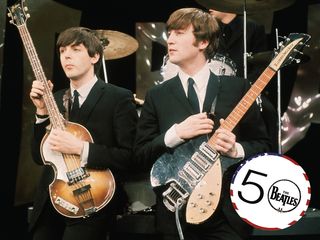
The Beatles' fab gear: 25 key pieces of kit
THE BEATLES IN THE USA: It's a good job The Beatles had taste. It's almost as if they knew that every instrument they laid their hands on would become iconic, because most of them - from Rickenbackers and Hofners through to gorgeous Gibsons and beyond - are desirable to say the least.
Of course, being consummate showmen as well as instinctively talented musicians, the gear they played always had to fulfill the dual roles of sounding great and looking fantastic on stage. In the whole of their career, they rarely got it wrong.
Arguably the two best recognised instruments of the lot are the '63 Hofner 500/1 bass that has become synonymous with Paul McCartney, and the battered '58 Rickenbacker 325 that John Lennon picked up in Hamburg and played right up to '64.
Both sounded great, and both had special qualities that set them apart. Crucially, Macca's bass could be played left handed, and its lightweight semi-hollow construction meant he felt free to roam all over the neck and create those iconic basslines. The '62 pictured here actually replaced an earlier model he bought in Hamburg, and is still being used by Sir Thumbsaloft today.
John's battle-scarred Ricky, a short-scale rhythm machine that perfectly suited his banjo-influenced style of strumming, was tinkered with almost to destruction by Lennon. At various times it was refinished, had the electrics messed with and was subject to all manner of dinks and scratches, but with effortless style and a rough jangly tone you'd be hard pushed to beat it.
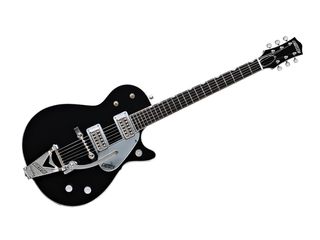
Gretsch Duo Jet
George Harrison's Gretsch Duo Jet was one of his first 'proper' American guitars, and it was with one of these black beauties that he perfected his inimitable lead style.
Another guitar that was broken in on sweaty Hamburg stages, it was also George's go-to electric for the now-legendary Cavern gigs, and you can hear it all over The Beatles' debut album Please Please Me.
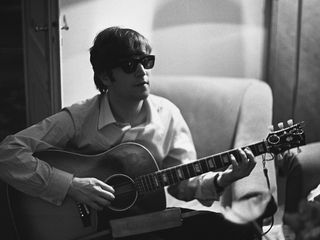
Gibson J-160E
John and George both snapped up a Gibson J160-E from a music shop in Liverpool in '62, and within a year the gorgeous looking guitars had become a key part of The Beatles image.
Featuring a rudimentary early electro-acoustic system, the sunburst Gibsons were used as the go-to live and recording acoustic through the majority of The Beatles' career. John had his refinished by The Fool in psychedelic colours, before eventually stripping it back to bare wood for use post-Beatles. Various re-issues have been released, with a high-end Gibson Lennon model currently in production.
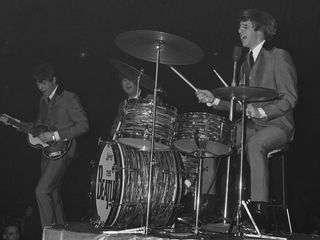
Ludwig 20" bass drum set
Ringo's Ludwig kit, with distinctive black finish and Beatles 'drop-t' head, is probably the most recognisable drum kit in history.
Iconic, and the sound that Ringo hammered out that distinctive early '60s backbeat on, it wasn't until '68 that he even considered another kit.
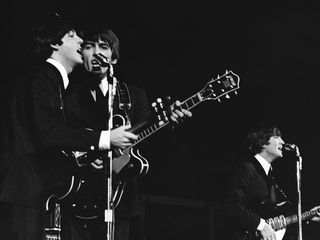
Gretsch Country Gentleman
When George wanted a new guitar as The Beatles rose up through the clubs, he went with another Gretsch, this time the semi-acoustic Country Gentleman.
Probably the guitar most associated with George, he could really make it sing - check out his peerless playing at the Royal Variety Performance to see what he could do with just a Country Gent, and AC30 and his fingers. Magic.
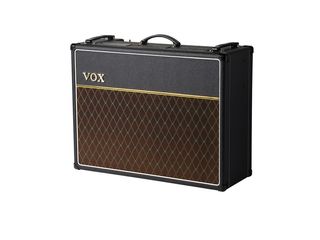
Vox AC30
While The Beatles went through various Vox amps throughout their early years, before eventually moving on to Fenders in the later period, there's no denying that the AC30 is the amp that's most associated with John and George's guitar sounds.
Even now, it's easy to see why - the AC30 is still right up there with the most used amps in the world thanks to its sweet break up and distinctive toppy twang. It went on to define the sound of the British Invasion, and has become the default sound for British rock of a certain vintage. John and George give Royalty a dose of their AC30s in the Royal Variety Performance footage below...
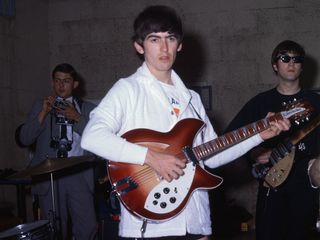
Rickenbacker 260/12
The defining sound of The Beatles in America, the Rickenbacker 360/12 went on to be much imitated, a jangle-monster that sounded quite unlike anything else and gave The Beatles' sound a fresh edge just as they broke into the stratosphere.
For all the imitators that followed, none mastered the tricky 12-string semi-acoustic quite like George. You need only listen to A Hard Day's Night for proof, that iconic opening chord unleashing Harrison's secret weapon on an unsuspecting public. We didn't have a chance, did we?

Epiphone Texan
If we had to associate a guitar with a single song, then the Epiphone Texan would almost certainly be the Yesterday guitar, with which Paul debuted the song on American TV.
No matter how many times you've heard the song, it's hard not to be knocked out by the sound of Macca playing it when it was still fresh:
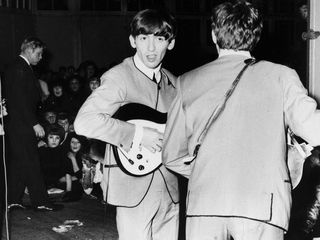
Rickenbacker 425
Picked up by George on a pre-Beatlemania trip to America, the Rickenbacker 425 was used by George as a reserve electric throughout '63.
In fact, you can clearly see him strumming away at it on a number of TV performances that year, and although he didn't go on to use it extensively, it's nevertheless an interesting little George guitar curio.
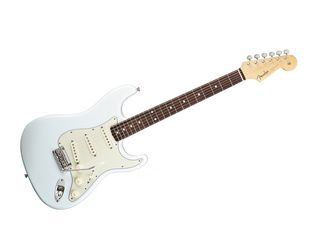
Sonic blue Fender Statocaster
They never played them live, but The Beatles' Sonic Blue Fender Stratocasters were regularly pulled out in the studio.
In fact, you can clearly hear them being played on Nowhere Man, the most obvious example of Strat tones anywhere in The Beatles back catalogue (check out the solo played by John and George simultaneously, both on their Strats). George would later paint his, transforming it into the famous Rocky guitar, as seen in the I Am The Walrus video.
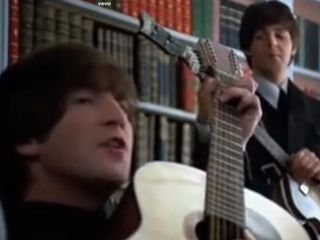
Framus Hootenanny 12-string
They really did love a 12-string, those Beatles.
This smart little Framus is best known as the guitar that featured on You've Got To Hide Your Love Away, one of Lennon's best folk-influenced songs. The Framus even made a cameo in Help!
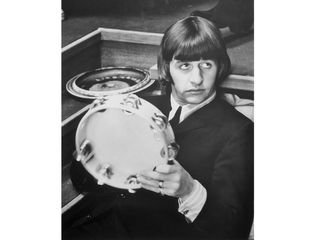
Tambourine
Appearing on every Beatle recording in some form or another, the humble tambourine - along with its even more basic little brother, the hand clap - added an unmistakable extra dimension to countless Lennon and McCartney compositions.
Taking their lead from the Motown records they loved, The Beatles almost always had a tambourine right to the fore in the mix. Which just goes to show that you cam buy the most expensive gear in the world, but sometimes all it takes it a something simple.
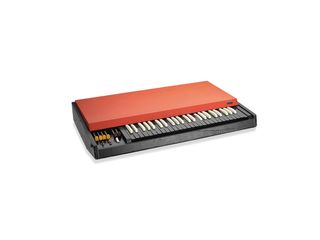
Vox Continental
What happens when you unplug John Lennon from his Rickenbacker? The answer was revealed in front of 50,000 odd fans at Shea Stadium: he goes loopy.
It was a Vox Continental that took some serious damage from the Lennon elbows at the legendary stadium gig, a brilliantly unhinged performance that you can see below:
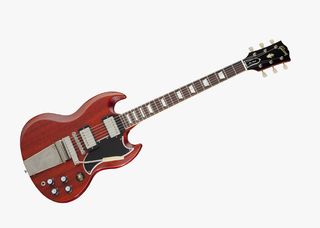
Gibson SG Standard
George turned to a '64 Gibson SG Standard with a Maestro Vibrola in the studio around 1966.
He'd have it to hand at pretty much every session for the next few years, the mixture of solid body and humbuckers giving him a bit of edge when he needed it. You can hear George's SG wrangling on Paperback Writer...
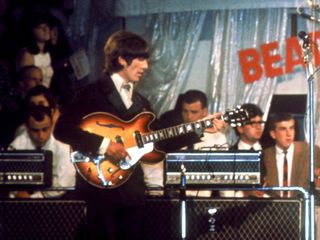
Epiphone Casino
The Epiphone Casino became the guitar of choice for both George and John for the last phase of their touring career.
Following the established Beatles pattern of looking ace and sounding pretty damned good as well, the Casino's distinctive P90 attack was everywhere as The Beatles decided touring wasn't for them. Check out John's way-too-loud Casino in the footage from this German gig...
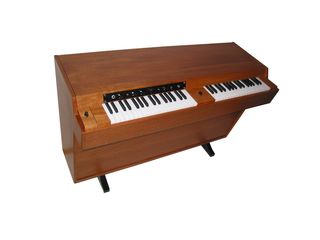
Mellotron Mark 2
You can almost picture the millions of furrowed brows that must have accompanied the first airing of Strawberry Fields Forever. What the hell was that haunting, slightly weird sound that threads its way through the song?
The answer of course is a Mellotron, a sort of proto-synthesiser that has gone on to be associated with '60s psychedelia ever since.
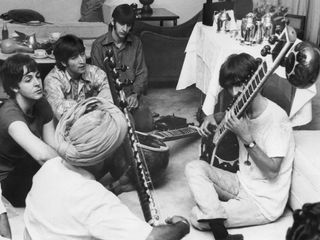
Sitar
George's first brush with a sitar occurred during the filming of Help! and the classical Indian instrument would go on to become a pet obsession.
Quite aside from broadening the horizons of popular music more than anyone before or since thanks to his appropriation of Eastern rhythms and sounds, George also proved that it's when guitarists push themselves beyond conventional boundaries that the magic really happens.
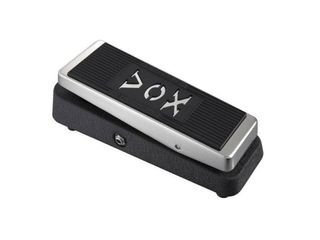
Vox V846
One of a few pedals utilized by The Beatles in the studio, the Vox wah was used to give Across The Universe its unearthly edge.
Other pedals that were used in recording sessions include the Fuzz Face and the Tone Bender, as well as assorted volume pedals.
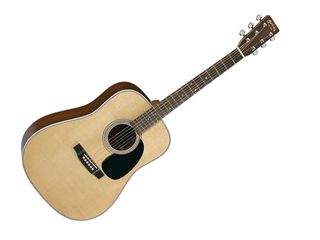
Martin D-28
A pair of Martin D-28s were picked up by John and Paul, guitars which found their way onto Beatles recordings around the time of recording The Beatles in a post-Rishikesh comedown in 1968.
You can heard them all over the folkier numbers of the latter period, including Blackbird and Two Of Us, and can see Lennon larking about with his in the video for Hello Goodbye.
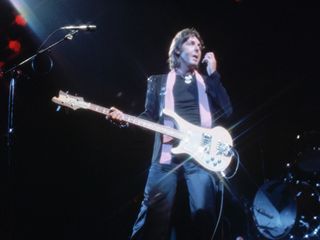
Rickenbacker 4001s
The bass that replaced the iconic Hofner in Paul's hands was a beautifully thick sounding Rickenbacker 4001s.
Given various paintjobs - including a highly psychedelic number that featured in the All You Need Is Love video - it gave Paul's studio playing more grit than the relatively plummy Hofner.

Gibson Lucy Les Paul
A refinished '57 Goldtop Les Paul that bounced between Eric Clapton and George Harrison, 'Lucy' was probably the most out and out rock guitar in the Beatles set up.
To hear it in all its blazing glory, check out the solo on While My Guitar Gentle Weeps...

Gibson J-200
The guitar that featured on arguably George's best known song, Here Comes The Sun, the Gibson jumbo was the key acoustic in Harrison's later Beatles career.
Allegedly the very same guitar that Bob Dylan is holding on the cover of Nashville Skyline, George's J-200 is probably the most recognisable Gibson acoustic of the late '60s.
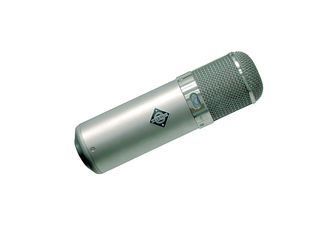
Neumann U47
The mic that was used on pretty much every Beatles recording, George Martin's preferred vocal mic and the holy grail for studios around the world, do we really need to say any more about this flawless piece of German audio engineering?

Fender Rosewood Telecaster
When things started to get heavy for The Beatles, George reached for a suitably weighty guitar - literally.
Fender custom made him the gorgeous rosewood Telecaster that he played throughout the Let It Be sessions, a famously heavy guitar that nevertheless provided a sweet tonal counterpoint - and several sublime solos - to the somewhat sour sessions.

NAMM 2025: “This innovative neck-to-body construction delivers more tone, sustain, and stability”: Eastman debuts the FullerTone series – all-new bolt-on electrics with a retro vibe and innovative neck joint

NAMM 2025: “A cornucopia of metal guitar specs” – ESP unveils LTD signature models for Slipknot's Mick Thomson, Whitechapel's Alex Wade, Rammstein's Richard Kruspe and more in epic launch

NAMM 2025: “This innovative neck-to-body construction delivers more tone, sustain, and stability”: Eastman debuts the FullerTone series – all-new bolt-on electrics with a retro vibe and innovative neck joint

NAMM 2025: “A cornucopia of metal guitar specs” – ESP unveils LTD signature models for Slipknot's Mick Thomson, Whitechapel's Alex Wade, Rammstein's Richard Kruspe and more in epic launch
Most Popular







